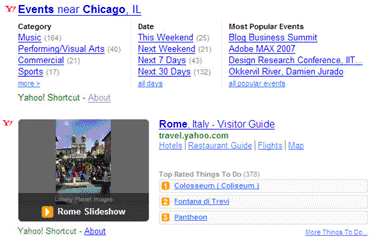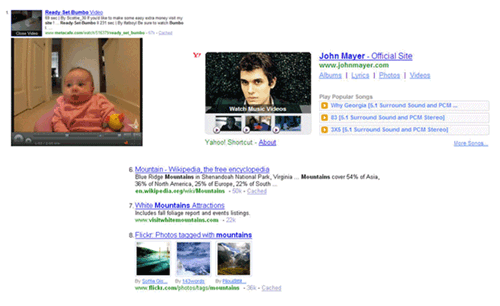Web Pro Interview: Larry Cornett

Being in second place means you have to work harder (and smarter). Yahoo! has been on a roll of late, this week introducing location-based FireEagle, but don't think for a minute that pure-search is not top of mind with the Sunnyvale-based company.
Website Magazine's Dante Monteverde interviewed Dr. Larry Cornett, Vice President of Consumer Products for Yahoo! Search on Yahoo! Shortcuts, the integration of multimedia in search, SearchMonkey and Yahoo! Boss.
1.) With the release of Yahoo! Shortcuts almost a year ago how has the reception been? Are Yahoo! searchers taking advantage of these advanced search features and using them? Do they find these "shortcuts" useful?
Absolutely. One of the things we know from our research is that our users struggle when they are searching on an unfamiliar topic. They often don't even know how to start their search. So in October 2007 we launched a significant new feature roll-out, which includes Yahoo! Search Assist and enhanced Yahoo! Shortcuts.
Search Assist (see below) essentially helps users overcome one of their key pain points, which is how to craft an effective query. As they begin to type their query or their keyword into the box it suggests other keywords that might be related to what they're typing. It also provides them the correct spelling of those keywords. And after they've conducted their initial search, Search Assist actually suggests related concepts based on their query to help them follow the right path to get the job done. 
We know from our research that another pain point for users is that search engines often don't provide the ultimate answer. They only help them down the path of finding the answer. And what we want to do at Yahoo! is actually start to begin to deliver what they really need within the search experience. So we're not just focused on the process of searching but really on the act of finding. And to that end we have also introduced enhanced Yahoo! Shortcuts (see below) that actually deliver the most relevant information that our users are seeking for particular types of searches.
So for example, if you type in the name of a movie at the very top of the search results page you get a link to a video trailer. You get local show times in your area, a link to a deeper description of that movie as well as reviews from critics and other Yahoo! users, right there at the top of the search results page. We're trying to deliver the most relevant information to our users immediately following their search to help make their job easier.
We know that this is resonating with users and Yahoo! was voted #1 in Search Assistance & Suggestions, according to December 2007 Keynote Systems study, "Keynote Customer Experience Rankings: Search".
2.) Tell us how the integration of multimedia search has gone. Google Universal Search gets all the attention but what features does Yahoo! image, video, and audio search have that separates it from the other Search Engines.
Yahoo! is committed to providing the best search experience to our users. We are constantly looking at new ways of incorporating different types of content into our search results. A great example is Yahoo! SearchMonkey which lets any publisher enhance their search results. This technology can be implemented by multimedia publishers who wish to have specifically stylized search results, which showcase the Yahoo! Search engine results page.
In addition to SearchMonkey, Yahoo! Search has also introduced multimedia integration including video, audio and photos (see below) directly into the search results, allowing consumers to get their answer -- whether it's a Web link, photo, video or music clip -- without leaving the page.

3.) Anything new to report on Yahoo! next generation search or social search? Will we be seeing any changes to Yahoo! soon?
We are entering a period of massive change to enable search engines to handle more complex content on the Web as content continues to grow, change, diversify and fragment. At the same time, users are performing increasingly sophisticated and open-ended tasks online, connecting broadly to content and services across the Web. Search engines are becoming more sophisticated and the simple search result page of ten blue text links is evolving to help address these complex tasks. Our aim is to define the intent of the consumer when they are in search.
As part of this evolution is the introduction of Yahoo! SearchMonkey, which developers and site owners can use to make Yahoo! Search results more useful and visually appealing, and drive more relevant traffic to their sites. For example, instead of just seeing a Wikipedia link and a snippet, you could call back to Wikipedia and show a photo, get more context about the article, maybe even present some of the external links or the edit history, whatever the publisher wants to do to enhance the result. A Yahoo! Local business listing could put structured information about itself as part of the result, like a photo of the store front and its main line number. Yahoo! SearchMonkey gives publishers a unique level of access to the SERP and let's them customize and enhance their result however they see fit. We've also recently introduced Yahoo! Search BOSS, which I go into more detail about below.
4.) Switching gears to Yahoo Site Explorer. What improvements have been made? How can Site Explorer benefit webmasters who want to optimize their Web sites?
Yahoo Site Explorer allows you to explore all the Web pages indexed by Yahoo! Search to view the most popular pages from any site and continues to be a great avenue to learn about what we are doing. We have been doing some great work learning from the last feature we launched, which was well-appreciated; the Dynamic URL Rewriting. This feature provides the ability for site owners to alert Yahoo! of the dynamic parameters in URLs that they'd like Yahoo! to ignore, which we'll then automatically rewrite accordingly. Dynamic URL Rewriting is a tool that we have seen in multiple examples as having really significantly increased the quality of the experience of site owners. In fact, while a colleague was speaking on a recent panel about this feature, someone in the audience from Disneyworld went to Site Explorer and set it up, and he is already seeing the benefits of what he had implemented.
5.) For years we have been told that Flash is not Search Engine friendly. What is Yahoo! doing to make flash content indexable and in turn displayed on their search engine results pages?
Adobe Flash (SWF) files is a controversial issue among Web developers and search engines because they have been difficult to crawl. Developers can create great visual effects with Flash, but search engine spiders can't see it and have historically been unable to extract content, such as text and links. They only look at the underlying HTML code of a Web page. That means important content may be hidden from search engines because it's embedded in Flash files instead of inside HTML code.
Recently, Adobe developed an optimized Flash player for search engines that allows search spiders to introspect and navigate through a live SWF application as if they were virtual users. That means any text or links in a Flash application can now be indexed, since it actually goes through the runtime of each Flash application and translates it into something the search engines can understand. We are committed to supporting webmaster needs with plans to support searchable SWF and are working with Adobe to determine the best possible implementation.
6.) Finally, can you tell us more about Yahoo! Search BOSS? What is this service, who does it cater toward, and how is it useful?
The Yahoo Search team recently announced the launch of Yahoo! Search BOSS - an open Web services platform that offers developers and companies the chance to create and launch Web-scale search products by utilizing the same infrastructure, technology and index that powers Yahoo! Search. BOSS fosters search innovation by enabling developers and companies to disrupt the search landscape by building their own world-class search experiences. BOSS currently lets developers re-rank and blend results, gives developers flexibility on the presentation of search results - it offers the ability to server up Web, news and image search and entitles search engines to unlimited queries. BOSS also offers a mash-up framework, which eliminates a lot of the heavy coding that goes into building the front end of a search engine. In addition to a self-serve API, we're also partnering with a handful of companies with large user bases or unique assets to collaboratively develop search experiences using Yahoo!'s search technology, called BOSS Custom.
With BOSS, you can build your own search engine - one that recognizes the difference between blogs, user reviews, news and shopping sites, and clusters results accordingly. Developers and companies can use BOSS to create a more social search engine, in which rankings are determined by a users' social graph and combined with newsfeed results, or conduct a visual search to present thumbnails of the Web pages instead of links, making it more user-friendly for non-savvy searchers. Essentially, BOSS will enable a range of fundamentally different search experiences for companies big and small.

Subscribe to Our Newsletter!
Latest in Marketing








